Rabbits can act as if they’re hardy creatures, but physically, they are in fact extremely delicate–from their skin to their spines to their external systems. Care must be taken to maintain their good health. The following basics are focused on general grooming and are necessary to know in order to groom rabbits safely and to help keep them healthy.
Daily and weekly grooming are essential to keep your bunny happy and healthy. Regularly groom your rabbit’s coat and toenails and examine their eyes, ears, teeth, soles, skin, and bunny butt. Be certain to stroll down to read about spot baths (no full-body baths) and incontinence for older or disabled rabbits.
The Rabbit's Fur Coat
Rabbits come in many shapes, sizes, and fur types. So do combs and brushes and other groom implements. You may need to try several grooming tools and techniques to find what works best for your fuzz-butt.Rabbits may shed every three months, or at the change of seasons. Every alternate time they’ll have a light shedding that may not be very noticeable. Next they’ll have a heavy shedding that you will not be able to escape.
As fastidious groomers, rabbits insist on being clean and tidy and will lick themselves like cats. And like cats, they can get hairballs if they ingest too much fur. Unlike cats however, rabbits cannot vomit. If hairballs are allowed to form they can become gigantic masses of tangled hair and food and will block the stomach exit, causing the rabbit to starve to death while their stomach appears to be very fat.
Rabbits need to be brushed at least weekly. In addition to removing any loose hair, this weekly brushing session helps prepare them for the multiple daily brushings that they must undergo when their heavy shedding begins. Rabbits will shed in different ways. Some take a couple of weeks or more to lose their old coat. Others will be ready to get rid of their extra fur all in one day, and these rabbits are the ones who cannot be neglected once they start shedding.
You can often remove quite a bit of loose fur by just gently pulling it out with your fingers or by stroking with a wet hand, which can collect the loose fur without releasing it into the air. But, however you remove it, remove it as soon as possible or your rabbit will do it during grooming.
Note that bald spots on rabbits are not uncommon when they are shedding. For instance, some may become nearly naked except for face and feet. If these bald spots occur from shedding, they will begin to grow back within a week or two. If these bare patches do not appear to be from shedding, watch the spot and check in with the rabbit’s veterinarian if it seems flakey, itchy, or inflamed.
Rabbit skin is delicate and highly susceptible to cuts, so mats should be gently split with pointed scissors or a mat splitter to take the mass apart. However, do not use the scissors to cut off the mat. It is way too easy to nip the tender skin. Bunny fur usually requires a finer blade than most cats and dogs.
Long-haired rabbits require a lot more attention than their short-haired cousins. If it is difficult to keep for you to brush and maintain their coat–or there are areas prone to matting–consider using a shaver to keep the rabbit’s hair trimmed to one inch or less. Otherwise you may be fighting hairballs and mats most of the time.
If you are not comfortable keeping up with your bunny’s coat, you can see about having a professional such as a vet tech at your rabbit’ s veterinary office or an experienced volunteer at your local HRS chapter show you how to keep your bunny looking and feeling healthy and neat.
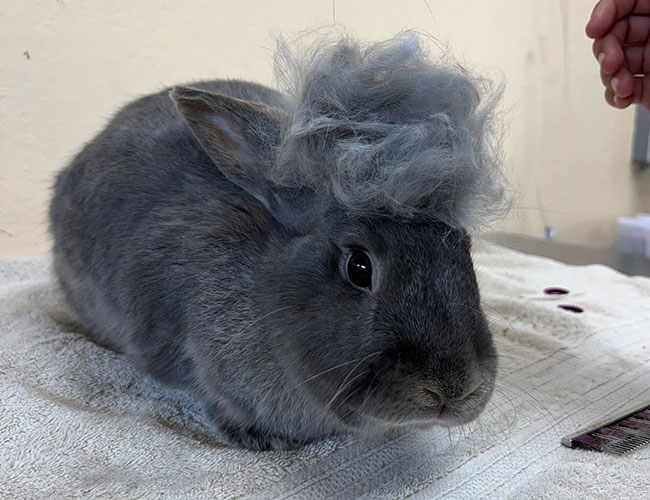
Skin
Scratchy, flaky skin with bald patches is usually a symptom of mites or, more rarely, an allergic reaction to fleas. Products described under “Safe Flea Treatments” will usually clear up such problems. A veterinarian should be consulted for such conditions as open sores or chronic skin inflammation.
Rabbits can pick up fleas or mites, from going outdoors or from other fuzzy animals in the household. Scratching or tiny specks of what looks like dirt along the spine can mean bunny has fleas. Another clue can be the curious habit of licking walls or the dewlap–that’s the fold of furry skin under the chin. Have you ever scritched your bunny at the base of their spine and they begin to lick the air or chest? There’s a place there some call “the tickle spot” that triggers this response. Parasites running along that spot also set this off. Small bits of skin resembling dandruff, especially along the spine, can indicate fur mites.
These flea treatments for cats are also safe to prevent and kill fleas on rabbits: Advantage (imidocloprid), Program (lufenuron), and Revolution (selamectin). (Note: Advantage has been known, rarely, to irritate the skin of certain rabbits.) Available by veterinary prescription, Revolution is our preferred method, as it is also effective against various types of mites that cause symptoms of mange, ear canker (ear mites), and “dandruff” (which is often caused by fur mites in the genus Cheyletiella). Contact your rabbit-savvy veterinarian for the dosage for each of your rabbits for any of these products. Each is applied to the back of the neck or other area where the bunny can’t readily groom it off.
It is also essential to thoroughly clean your rabbit’s sleeping and exercise areas with each treatment to control re-infestation, since fur and dander in the environment may contain flea or mite eggs. In addition, a flea comb is a non-toxic device that takes more patience but is both physically and psychologically rewarding. Most rabbits learn to love the attention of being flea combed, and it can be used as a supplement to your main flea-control program.
- Frontline (fipronil) has been linked to neurological damage and death in rabbits, although this product is apparently safe for dogs and cats. The manufacturer (Merial) has placed a warning on the Frontline label stating that Frontline should never be used on rabbits.
- Flea powders, even those considered safe for cats and kittens or advertised as “rabbit safe”, are not recommended for use on rabbits.
- Flea shampoos, even those considered safe for cats and kittens or advertised as “rabbit safe”, are not recommended for use on rabbits. Bathing of rabbits, in general, is strongly discouraged because the stress of the bath itself can cause serious health problems, and has in some cases been linked to the death of the rabbit. Flea baths or dips are NOT recommended for this reason.
- For environmental flea control, sprays and “bombs”are not recommended, as they may leave harmful residue that the rabbit can ingest. Safer alternatives include borax and food-grade diatomaceous earth. These can be worked into the carpet where fleas leave their eggs. The carpet should then be thoroughly cleaned with all residue removed to prevent harmful inhalation by your rabbit. The rabbit should not be in the room when diatomaceous earth is applied and during its removal. Diatomaceous earth should never be used on a rabbit.
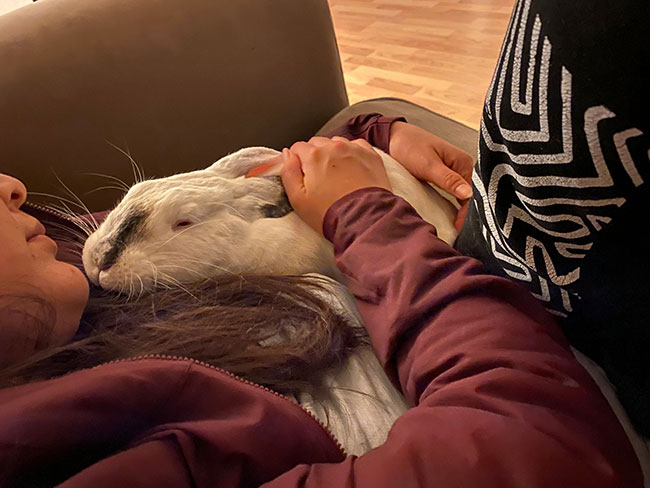
Feet
"These feet were made for hoppin,' and that's just what they do. E-v-ery day these feet are gonna hop all over you." Rabbits rely on their hoppers to get around. It's up to you to keep them in tip-top shape.- Mani/Pedi. Rabbits periodically need to have their nails trimmed, in the same way as dogs and cats. It depends on the rabbit and their floor surfaces as to how frequently they’ll need their mani/pedis, but every four to eight weeks is usual. If not kept trimmed, their nails can grow to be very long and sharp and will be uncomfortable for the rabbit. Baby rabbits in particular have sharp, pointy nails.
- Watch for the Quick. Rabbit nails are a bit tricky because they have blood flow in their nails. The trick is to clip only the tip of the nail and not cut the “quick.” If the rabbit has light colored nails they are easy to trim. You can see the blood (quick) inside the nail and you clip just before that point. Dark nails are harder to see where they should be clipped, but it is still visible. Backlighting the nails with a flashlight can make the quick more visible.
- Nipped the Quick? Some people are afraid to clip nails for fear that they will cause the rabbit to bleed. While you can keep styptic powder or cornstarch on hand in case a nail is cut too short and bleeds, an alternative option is to just hold pressure on the nail with a cotton ball.
- Ask a Professional. For guardians who prefer not to trim their rabbit’s nails or would like an in-person lesson on how to do it, they can make an appointment with a vet tech at their rabbit’s doctor’s office or with an HRS chapter volunteer, to do the trimming. By the way, declawing is definitely NOT appropriate for rabbits.
The bottom of a rabbit’s foot is not padded like a cat or dog. It more resembles a person’s foot, except with a layer of short fur. If this protective fur layer becomes worn down, it may lead to a small or large bare spot, exposing the foot to possible inflammation or callused skin. In this case, soft surfaces that will not remain wet–such as such as washable puppy pee pads–should be provided. Exposed skin that becomes urine burned or broken is also likely to infect. Take extra care that rugs and litterboxes are kept clean and dry.
If excessive digging or scratching is a problem, then a large box of hay or straw, where bunny can pursue these activities, may help. A box of untreated paper used for box packaging or shredded paper also works, so long as the rabbit does not ingest more than a few bites of it. For rabbits who may like to kick the litter out the box, there are special screens to lay over the litter available from some pet supply stores that focus on rabbits.
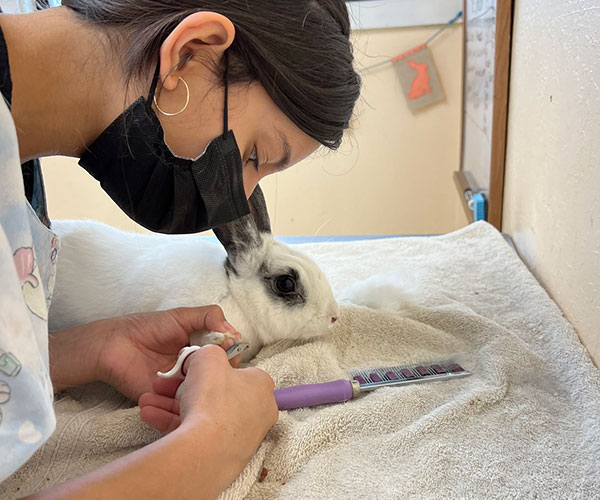
Teeth
Bunnies with straight (aligned) incisors will keep them worn down with everyday gnawing and chewing. The contact of top teeth rubbing against the bottom teeth immediately below helps keep the ever-growing teeth even and in check. On the other hand, a rabbit with a malocclusion, or crooked incisors, will need to have their incisors kept trimmed by a veterinarian using a dental Dremel tool while the bunny is comfortably sedated. If malocclusion is left untreated, the rabbit will be in pain and may not be able to eat as the teeth grow like tusks in every direction. Left untreated, the rabbit could starve to death. Malocclusion can be the result of genetics, injury, or age.
Bunnies will also generally keep their molars worn down by eating hay. Bunnies who develop molar points or spurs will need to have their molars trimmed with dental tools by a veterinarian while the bunny is under anesthesia.
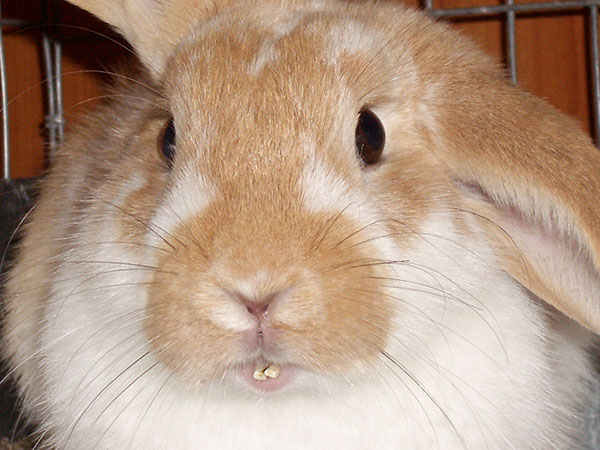
Eyes & Ears
Be certain to have any watery eye or eye discharge diagnosed by your rabbit’s veterinarian. In addition to any medications or eye drops, the cheeks need to be kept dry and clean so the area will not become chafed or cause the fur to fall out. Clean tissues will absorb mild wetness. Ophthalmic saline solution (what people use with their contacts) carefully poured onto the cheek will crystallize the tears so that they can be removed with a clean flea comb. A touch of prescription anesthetic powder on a finger can be applied to the area if there are painful lesions.
Ear wax can be lifted out with a cotton swab, being careful not to push the wax into the canal, or you can try a mild ear cleaner containing Chlorhexidine, such as Nolvasan Otic. For ear mite infestation, consult your rabbit-savvy veterinarian, who may recommend applying a topical medication such as Mitox or Revolution between the shoulder blades. Touching a rabbit’s ears or trying to detach the ear mites crust is NOT recommended as the rabbit’s ears will be painful and it may tear the skin. The crust will fall out after treatment Larger, detached segments can be gently removed with a Q-tip.
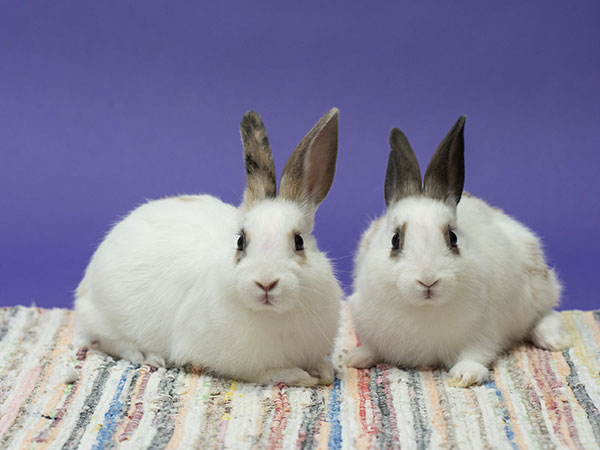
Bathing, Spot Cleaning, & Incontinence
Because seemingly healthy rabbits can have undiagnosed problems, it’s best not to subject them to the stress of a bath. If your rabbit is badly infested with fleas, there’s a good chance that they are already compromised and may go into shock when bathed. There are safe alternatives for flea control. (See the section above called, “Fleas and Mites.”)
The vast majority of rabbits, like their ancestors, do not enjoy getting wet. A full bath is quite stressful to the average rabbit, and is not recommended. A butt bath with a very low level of warm water might be needed for rabbits who are unable to clean their bunny bums due to age, illness, or injury.
Because seemingly healthy rabbits can have undiagnosed problems, it’s best not to subject them to the stress of a bath. If your rabbit is badly infested with fleas, there’s a good chance that they are already compromised and may go into shock when bathed. There are safe alternatives for flea control. (See the section,“Fleas and Mites.”)
In addition, because a thoroughly wet rabbit takes a very long time to dry, spot cleaning the dirty area with an application of baby cornstarch, which is available at supermarkets in the baby section, is a better option. (But, do not use talcum, as it is carcinogenic.) After applying a small amount of baby cornstarch to the soiled area, gently comb out the dirt with a fine flea comb. There are times also when a bit of spot cleaning may be necessary, but avoid the full-body bath.
A wet rabbit can quickly become hypothermic. If your rabbit is wet to the skin for any reason, be sure to thoroughly blow dry the bunny until even the undercoat is dry and fluffy. Before the blow dry, use a quick-absorbent microfiber towel to gently soak up water to reduce the amount of time required to get the fur completely dry.
Normal rabbit body temperature ranges from 101oF – 103oF. Because rabbit skin is very delicate–and rabbits are sensitive to heat–never use a blow dryer on a setting higher than “warm” and constantly monitor the temperature of the air on the bunny’s skin by placing your hand in its path. Also do not concentrate the heat on one area for too long, by keeping the dryer moving at all times.
A rabbit with a urinary infection, one who may be disabled, or a senior rabbit may not be able to project urine away from the body. The result may be saturated fur around the hindquarters. For milder cases, shave the areas that get wet so the skin can dry (remember, rabbit fur takes a long time to dry), rinse the affected areas daily, and follow up with a dusting of baby powder or cornstarch. For more infirm cases, disposable baby diapers–turned backwards so the tabs face up–do wonders for keeping the moisture away from the skin. (Huggies Step 2 work well for an eight-pound rabbit.)
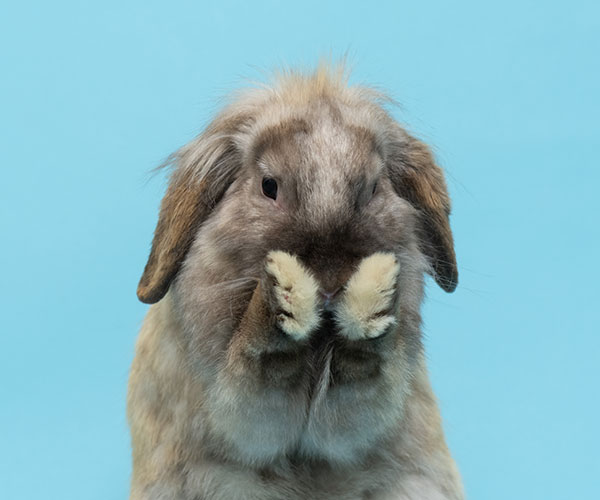
Sign up to Our Newsletter!
Sign up for web update alerts and our monthly e-newsletter
to stay current on HRS, our Chapters, and info for your bunny.



